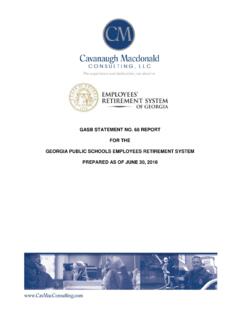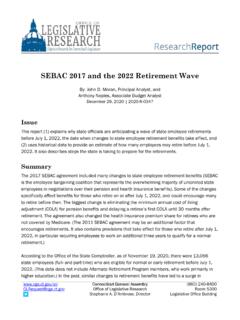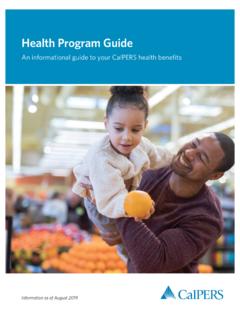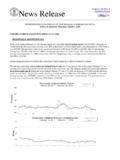Transcription of 401(k) AND 457 PLANS HANDBOOK
1 401(k) AND 457 PLANS HANDBOOKP each State Reserves (PSR) gives you an easy and effective way to save for retirement. It provides a way for you to save a portion of your income before state and federal income taxes are assessed on that income, with the contributions and associated earnings and dividends accumulating tax-deferred until withdrawn after termination of service (some in-service withdrawals are permissible see Distributions/Withdrawals). It also provides a way for you to contribute after-tax dollars, with both contributions and the investment earnings on those contributions available for distribution tax-free (as long as you meet certain IRS requirements). Your money is invested in your choice of investment options offered through PSR.
2 Because PSR s purpose is to help you save for retirement, your ability to take money out is very limited prior to separation from offers two PLANS for employees to use a 457 plan and a 401(k) plan. The State of Georgia Employees Deferred Compensation 457 Plan operates as an eligible state and local government deferred compensation plan under the provisions of Section 457 of the United states Internal Revenue Code. The State of Georgia Employees Qualified Trust Deferred Compensation 401(k) Plan operates under the provisions of Section 401(k) of the United states Internal Revenue Code. Eligibility for PSR ..1 Georgia State Employees Pension and Savings Plan Eligibility ..1 Employer Contributions and Vesting ..1401(k)/457 Plan Comparison.
3 2 Contributions ..3 Fee Structure ..4 Investment Restriction and Frequent Trading Policy ..7 Distributions, In-Service Withdrawals, and Tax Liability ..8 Beneficiaries ..9 Investment Advice ..10 Account Started In Three Easy Steps ..11 For More Information ..12 What s inside?ELIGIBILITY FOR PSRAll full-time state employees and other government employees eligible for membership in the Employees Retirement System (ERS) retirement plan, as well as employees of Fayette, Baldwin, Henry, and Walton County Boards of Education and participating university systems are eligible for PSR. Part-time and hourly employees may or may not be eligible check with your Human Resources office about benefit eligibility. Employees of the Georgia Lottery Corporation are only eligible for the PSR 401(k) Plan, not the PSR 457 STATE EMPLOYEES PENSION AND SAVINGS PLAN ELIGIBILITYS tate government employees hired on or after January 1, 2009, and eligible for retirement benefits through the ERS Georgia State Employees Pension and Savings Plan (GSEPS) are automatically enrolled in the PSR 401(k) Plan at a pre-tax contribution rate of 5%, with contributions invested into the Lifecycle Fund that corresponds to your date of birth (see page 6).
4 In lieu of the default Lifecycle Fund investment option, you may also choose other investment options available through the Plan (see Investment Options). GSEPS provides matching employer contributions up to 3% with a participant contribution of 5%, as described below: Participant contributes 1% of compensation and receives 1% salary match from state (100% match on the first 1% of compensation contributed). For each additional 1% contributed by participant (up to 4%), the state will match 50% of that amount (up to 2% of compensation).EMPLOYER CONTRIBUTIONS AND VESTINGGSEPS-covered state employees, as well as eligible employees of the Community Service Boards, the Georgia Lottery Corporation, and Henry County and Walton County Board of Education employees covered under the Public School Employees Retirement System may receive an employer contribution to the 401(k) Plan, either a matching contribution or a designated percentage contribution (the GSEPS match is described in the previous section).
5 Please contact your Human Resources office for more information about employer contribution eligibility. Employer contributions are invested into the Lifecycle Fund that corresponds to your date of birth (see page 6). In lieu of the default Lifecycle Fund investment option, you may also choose other investment options available through the Plan (see Investment Options). The account balance of the 401(k) employer contribution is subject to a five-year vesting schedule, vesting 20% for each continuous, completed year of service. After five continuous years of service, the employer balance portion of the account is 100% vested. Vesting for GSEPS employees who transfer to a non-GSEPS position will cease at the time of transfer.
6 Vesting for Henry and Walton County Board of Education employees who transfer to another employer that offers Peach State Reserves will cease at the time of transfer. Vesting for Community Service Board and Georgia Lottery Corporation employees who transfer to another employer that offers Peach State Reserves will continue to accrue. (A transfer is defined as a break in employment service of 31 days or less.)For rehired employees with a previous employer balance, a break in service of greater than 31 days will result in a new vesting period for employer money contributed after the new hire date. A paid or unpaid leave of absence is not considered a break in service, unless the leave of absence is greater than 365 consecutive calendar days, in which case the break in service would begin at the end of that 365-day period of leave, if the absence continued.
7 1401(k) AND 457 PLAN COMPARISONIn general, 401(k) and 457 PLANS are very similar; both provide after-tax Roth and tax-deferred contributions and earnings and are subject to many of the same tax provisions within the Internal Revenue Code related to tax-advantaged retirement PLANS . However, there are some key distinctions between the PLANS . Distributions from 401(k) PLANS are subject to early withdrawal penalties in most cases, if taken prior to age 59 or, if retiring in the year of reaching age 55, if taken prior to that year. Under current tax law, the early withdrawal penalty does not apply to 457 plan balances. Additionally, 401(k) participants, if married, must designate their spouse as 100% sole primary beneficiary, unless the spouse signs a waiver consenting to a different beneficiary designation.
8 This requirement does not apply to 457 plan beneficiary designations. The 457 Plan offers a significant tax-sheltered savings opportunity as retirement approaches, which is not available in the 401(k) Plan (see Contributions Special 457 Catch-Up). Depending upon your retirement plan participation, 401(k) participants may be assessed a quarterly flat-dollar fee (see Fee Structure). For a summary of the 401(k) and 457 Plan features, see the following plan comparison (k) Plan457 PlanParticipationEligibilityAll full-time state and participating university system employees and other government employees eligible for membership in the ERS retirement plan, as well as employees of Fayette, Baldwin, Henry, and Walton County Boards of Education.
9 Part-time and hourly employees may or may not be eligible check with your Human Resources office about benefit eligibility. Employees of the Georgia Lottery Corporation are not eligible for the state 457 enrollment for eligible employees is available at any may transfer assets into PSR from their previous employer s 401(k), 403(b), or 457 PLANS , or in some cases, from IRAs. Upon termination, you may transfer assets to your new employer s retirement plan or to an IRA, but there is no requirement to do so. Employees may transfer assets into the 457 Plan only from other 457 PLANS . If you d like to participate in the 457 Plan but want to roll over other plan assets into PSR, you can roll over non-457 plan assets into the 401(k) Plan and still contribute through payroll deduction to the 457 Plan (there is no additional cost for maintaining a balance in both PLANS ).
10 Upon termination, you may transfer assets to your new employer s retirement plan or to an IRA, but there is no requirement to do LimitsContributions can be made between 1% and 80% of compensation per pay period. The maximum contribution for 2022 is $20,500, which includes your combined pre-tax and Roth ContributionsAge 50 and over contribution: Employees age 50 or older (or who will reach age 50 in the applicable tax year), may make additional contributions, beyond the normal contribution limit, of up to $6,500 in 2022 for a total contribution of $27,000, which includes your combined pre-tax and Roth available in the 401(k) 457 Catch-Up: Double the normal contribution limit during the three years prior to the year of your retirement, if eligible.










